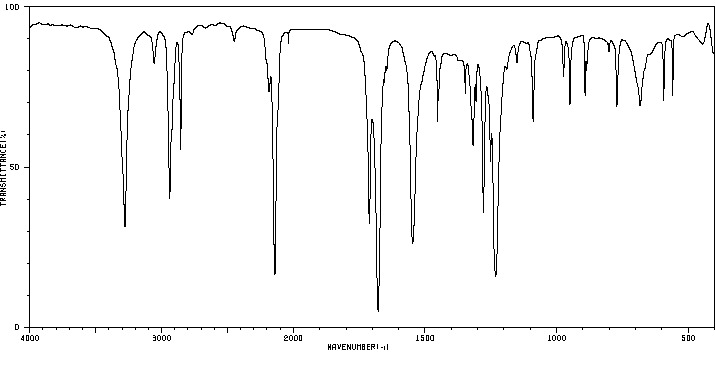cyclohexylcarbamoyl azide | 54614-94-7
分子结构分类
中文名称
——
中文别名
——
英文名称
cyclohexylcarbamoyl azide
英文别名
Carbamic azide, cyclohexyl-;1-cyclohexyl-3-diazourea
CAS
54614-94-7
化学式
C7H12N4O
mdl
——
分子量
168.198
InChiKey
SLRZLOHKQNQIOI-UHFFFAOYSA-N
BEILSTEIN
——
EINECS
——
-
物化性质
-
计算性质
-
ADMET
-
安全信息
-
SDS
-
制备方法与用途
-
上下游信息
-
文献信息
-
表征谱图
-
同类化合物
-
相关功能分类
-
相关结构分类
物化性质
-
熔点:105.1 °C
计算性质
-
辛醇/水分配系数(LogP):3.3
-
重原子数:12
-
可旋转键数:1
-
环数:1.0
-
sp3杂化的碳原子比例:0.86
-
拓扑面积:43.5
-
氢给体数:1
-
氢受体数:2
SDS
反应信息
-
作为产物:参考文献:名称:碘苯二氯化物与叠氮化钠联用在醛中有效合成氨甲酰叠氮化物摘要:在氮气下,使用二氯化碘苯和叠氮化钠在乙腈中的组合试剂系统,可以将各种脂肪族和芳香族醛转化为其相应的氨基甲酰基叠氮化物,产率从良好到极好。DOI:10.1055/s-2008-1067196
文献信息
-
One-Pot Synthesis of Carbamoyl Azides Directly from Primary Alcohols and Oxidation of Secondary Alcohols to Ketones Using Iodobenzene Dichloride in Combination with Sodium Azide作者:Xiao-Qiang Li、Wei-Kun Wang、Chi ZhangDOI:10.1002/adsc.200900428日期:2009.10An effective synthesis of carbamoyl azides directly from primary alcohols using iodobenzene dichloride in combination with sodium azide has been developed. Moreover, the same regent combination was also efficient for the oxidation of secondary alcohols to the corresponding ketones.
-
Phosphorus in organic synthesis—VII作者:K. Ninomiya、T. Shioiri、S. YamadaDOI:10.1016/s0040-4020(01)97352-1日期:1974.1(DPPA). The reaction procedure is quite simple, occurring by refluxing an equimolecular mixture of a carboxylic acid, DPPA, and triethylamine in the presence of a hydroxyl component. Aromatic, aliphatic, and heterocyclic carboxylic acids underwent rearrangements in satisfactory yields. As this modified Curtins reaction is much simpler and less laborious than the classical Curtius reaction and proceeds
-
Radical Azidonation of Aldehydes作者:Lavinia Marinescu、Jacob Thinggaard、Ib B. Thomsen、Mikael BolsDOI:10.1021/jo035163v日期:2003.11.1Aliphatic and aromatic aldehydes can be converted to acyl azides by treatment with iodine azide at 0-25 degrees C. If the reaction is performed at reflux Curtius rearrangement occurs and carbamoyl azides are obtained in 70-97% yield from the aldehyde. The reaction was shown to have a radical mechanism.
-
Synthesis of Carbamoyl Azides from Primary Amines and Carbon Dioxide under Mild Conditions作者:Eduardo García-Egido、Miryam Fernández-Suárez、Luis MuñozDOI:10.1021/jo702506v日期:2008.4.1Treatment of amines under a carbon dioxide atmosphere with tetramethylphenylguanidine (PhTMG) and diphenylphosphoryl azide (DPPA) in acetonitrile below 0 °C provides carbamoyl azides in high to excellent yields. In addition, epimerization is not observed when optically pure α-amino esters are used as substrates.
-
Synthesis of carbamoyl azides via the Lossen rearrangement utilizing diphenyl phosphorazidate作者:Kotaro Ishihara、Takayuki Shioiri、Masato MatsugiDOI:10.1016/j.tetlet.2022.153727日期:2022.4A novel method was developed for the synthesis of carbamoyl azides from hydroxamic acids via the Lossen rearrangement using diphenyl phosphorazidate, which acts as both the activator and azide source to produce the azides via an isocyanate intermediate. Using this method, various hydroxamic acids were converted into the corresponding carbamoyl azides, enabling their preparation without the use of highly
表征谱图
-
氢谱1HNMR
-
质谱MS
-
碳谱13CNMR
-
红外IR
-
拉曼Raman
-
峰位数据
-
峰位匹配
-
表征信息
同类化合物
顺式-2-硝基环己基乙酸酯
顺式-2-硝基-6-甲基环己酮
雷尼替丁杂质18
铝硝基甲烷三氯化物
钾离子载体III
重氮(硝基)甲烷
醛基-七聚乙二醇-叠氮
过氧亚甲基
辛腈,4-氟-4-硝基-7-羰基-
辛烷,1,2-二氯-1-硝基-
赤霉素A4+7(GA4:GA7=65:35)
苄哒唑
羟胺-四聚乙二醇-叠氮
羟胺-三乙二醇-叠氮
米索硝唑
磷酸十二醇酯
碘硝基甲烷
碘化e1,1-二甲基-4-羰基-3,5-二(3-苯基-2-亚丙烯基)哌啶正离子
硝酰胺
硝基脲银(I)复合物
硝基甲醇
硝基甲烷-d3
硝基甲烷-13C,d3
硝基甲烷-13C
硝基甲烷-(15)N
硝基甲烷
硝基甲基甲醇胺
硝基环辛烷
硝基环戊烷
硝基环戊基阴离子
硝基环庚烷
硝基环己烷锂盐
硝基环己烷钾盐
硝基环己烷
硝基环丁烷
硝基氨基甲酸
硝基新戊烷
硝基二乙醇胺
硝基乙醛缩二甲醇
硝基乙醛缩二乙醇
硝基乙腈
硝基乙烷-D5
硝基乙烷-1,1-d2
硝基乙烷
硝基乙烯
硝基丙烷
硝基丙二醛(E,E)-二肟
硝基丙二腈
硝基-(3-硝基-[4]吡啶基)-胺
硝乙醛肟







